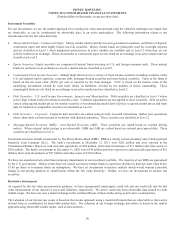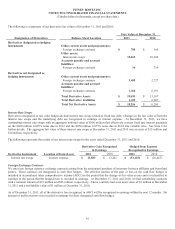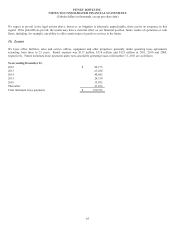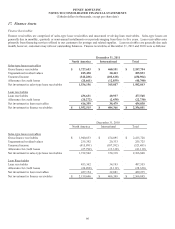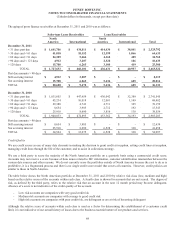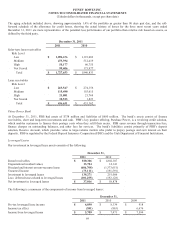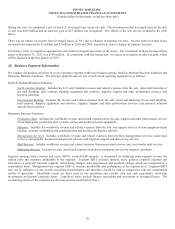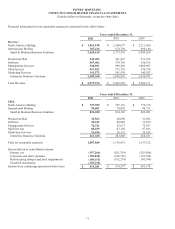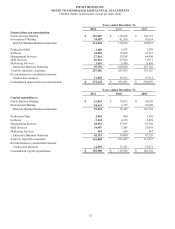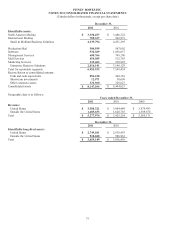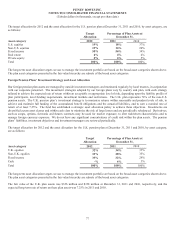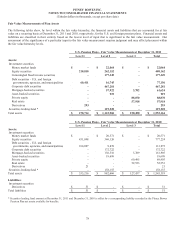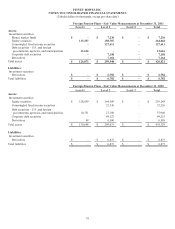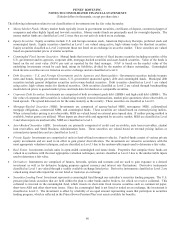Pitney Bowes 2011 Annual Report Download - page 88
Download and view the complete annual report
Please find page 88 of the 2011 Pitney Bowes annual report below. You can navigate through the pages in the report by either clicking on the pages listed below, or by using the keyword search tool below to find specific information within the annual report.
PITNEY BOWES INC.
NOTES TO CONSOLIDATED FINANCIAL STATEMENTS
(Tabular dollars in thousands, except per share data)
70
During the year, we completed a sale of non-U.S. leveraged lease assets for cash. The investment in that leveraged lease on the date
of sale was $109 million and an after-tax gain of $27 million was recognized. The effects of the sale are not included in the table
above.
There was no impact on income from leveraged leases in 2011 due to changes in statutory tax rates. Income from leveraged leases
was positively impacted by $2 million and $3 million in 2010 and 2009, respectively, due to changes in statutory tax rates.
In February 2012, we signed an agreement to sell certain leveraged lease assets to the lessee. The investment in these leveraged lease
assets at December 31, 2011 was $109 million. In connection with this transaction, we expect to recognize an after-tax gain, which
will be finalized in the first quarter of 2012.
18. Business Segment Information
We conduct our business activities in seven reporting segments within two business groups, Small & Medium Business Solutions and
Enterprise Business Solutions. The principal products and services of each of our reporting segments are as follows:
Small & Medium Business Solutions:
North America Mailing: Includes the U.S. and Canadian revenue and related expenses from the sale, rental and financing of
our mail finishing, mail creation, shipping equipment and software; supplies; support and other professional services; and
payment solutions.
International Mailing: Includes the revenue and related expenses from the sale, rental and financing of our mail finishing,
mail creation, shipping equipment and software; supplies; support and other professional services; and payment solutions
outside North America.
Enterprise Business Solutions:
Production Mail: Includes the worldwide revenue and related expenses from the sale, support and other professional services
of our high-speed, production mail systems, sorting and production print equipment.
Software: Includes the worldwide revenue and related expenses from the sale and support services of non-equipment-based
mailing, customer relationship and communication and location intelligence software.
Management Services: Includes worldwide revenue and related expenses from facilities management services; secure mail
services; reprographic, document management services; and litigation support and eDiscovery services.
Mail Services: Includes worldwide revenue and related expenses from presort mail services and cross-border mail services.
Marketing Services: Includes revenue and related expenses from direct marketing services for targeted customers.
Segment earnings before interest and taxes (EBIT), a non-GAAP measure, is determined by deducting from segment revenue the
related costs and expenses attributable to the segment. Segment EBIT excludes interest, taxes, general corporate expenses not
allocated to a particular business segment, restructuring charges, asset impairments and goodwill charges which are recognized on a
consolidated basis. Management uses segment EBIT to measure profitability and performance at the segment level. Segment EBIT
may not be indicative of our overall consolidated performance and therefore, should be read in conjunction with our consolidated
results of operations. Identifiable assets are those used in our operations and exclude cash and cash equivalents, short-term
investments and general corporate assets. Long-lived assets exclude finance receivables and investment in leveraged leases. The
accounting policies of the segments are the same as those described in Note 1.


